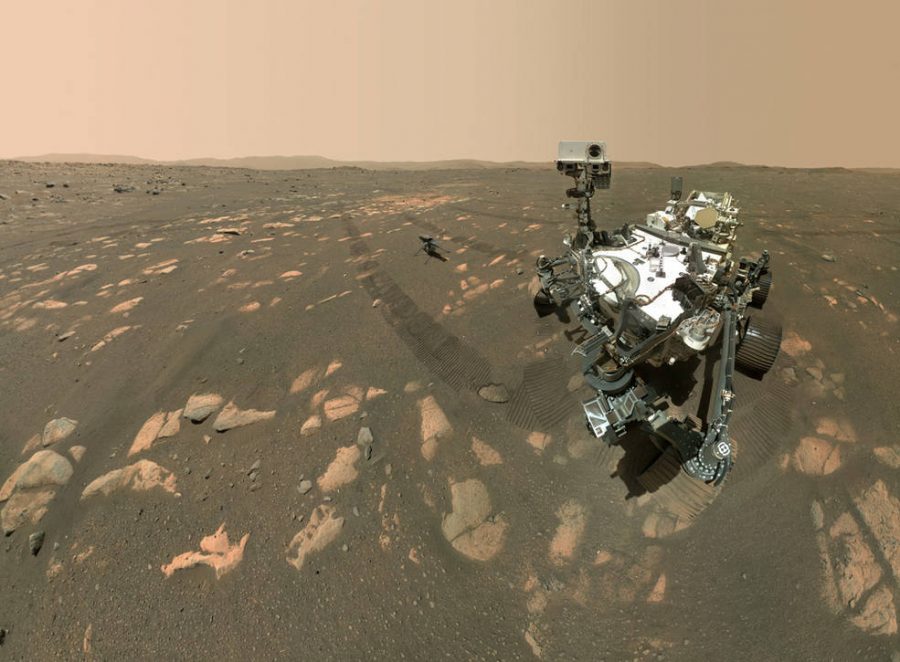NASA Rover “Perseverance” Arrives on Mars. What’s the Next Step in its Journey?
April 28, 2021
On Thursday February 18, the seven-month-long journey of the Mars rover Perseverance came to a close with its successful touchdown on Mars. Perseverance was sent with the mission of bringing back samples of rock that lie deep beneath the martian planet’s surface.
Perseverance, nicknamed “Percy”, is a six-wheeled, 2,260-pound rover that was launched on July 30, 2020 on an Atlas V rocket. The rover is equiped with a small helicopter named Ingenuity which has become the first aircraft to fly over and take aerial photos of the Red Planet. Perseverance also has 24 cameras and two microphones that allow NASA, as well as the general public, to stay up-to-date with the mission. Since it’s deployment on Mars, Percy has taken hundreds of video clips, pictures, and soundbites including the first audio clip to ever be recorded on another planet. While the audio mainly recorded the sound of blowing wind, it still marks an important first in the history of space travel.
The first video to be sent back to NASA was recorded as Perseverance dropped its heat shield and began its descent into Mars’s atmosphere. Upon the rover’s initial descent, Percy was traveling at a speed of 12,100 miles per hour—sixteen-times the speed of sound. The last seven minutes of the landing, known by technicians as “The seven minutes of terror,” due to just how difficult it is to land, is pre-programmed into the rover, meaning NASA control teams couldn’t interfere in any way. Once the rover was within one-mile of the planet’s surface, the descent module fired its engines downward to slow the landing, and identify a safe landing spot.
The landing spot deemed safest by Perseverance’s navigation system was named Jezero Crater. At just five-miles in diameter, Jezero Crater is the smallest landing target attempted by a Mars rover. Located just north of Mars’s equator, Jezero Crater is believed to be an ancient dried up river delta, which made it a prime location to begin Perseverance’s mission on the martian planet. Since water is believed to have filled the crater some three-to-four billion years ago, experts believe that it is a likely place to find signs of past microscopic life within the dirt and soil. Using it’s seven-foot robotic arm, Percy is tasked with collecting dozens of rock samples and minerals that will later be picked up by a second craft and brought back to Earth sometime in early 2030.
Perseverance is the ninth spacecraft sent by the U.S to land on Mars, with predecessors being Viking 1 and 2 (1976), Pathfinder (1997), Spirit and Opportunity (2004), Phoenix (2008), Curiosity (2012), and InSight (2018). Perseverance is the largest and most advanced rover to ever be sent to another planet, and, rather just analyzing whether the planet could have ever been home to life like many of the previous rovers, Percy will be looking directly for signs of past life within Mars’s rock.
In addition to gathering samples and studying the planet’s geology and climate, Perseverance will also be experimenting with how to convert carbon dioxide into oxygen in an effort to potentially create breathable air for future astronauts. NASA hopes that these experiments will also allow scientists to create a product of rocket fuel that can be accessed and used by future rovers and crafts that arrive on Mars.
This journey to Mars will be able to help us get closer to the answer of whether or not humans are alone in our galaxy. By discovering if any microscopic organisms had ever lived on Mars, scientists can determine if it is possible for a seemingly desolate planet such as Mars to have ever been inhabitable, even by life forms as simple as microorganisms.
As with every mission that has taken humans even deeper into the discovery of space, Perseverance’s journey to Mars marks a historic accomplishment that will surely change the course of space travel and martian-planet exploration for the rest of time..


